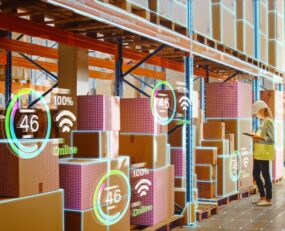
Supply chain visibility is critical for the provision of effective logistics. As we have stated many times, this must also encompass every operational environment beyond the track and trace of transportation assets. Understanding the nature and location of inventory throughout the supply chain is vital. But for many companies this is very difficult to achieve.
Depending on the nature of the business, may it be as a manufacturer, supplier or logistics service provider, how inventory is handled and managed could be quite different. They will have different information systems handling this task, each instance may hold the inventory data in their own unique way. There may be multiple sites and stock locations involved, adding to the potential for further complication. All of this needs constant vigilance when recording what comes in, what goes out, and what remains.
This also requires regular and accurate stock taking exercises to confirm the alignment of what the systems say is there, and what is actually there. I am sure we all have examples when this is not the case. As supply chain operations have evolved over the past decade in response to multiple external events, many robust but very inflexible inventory management systems, have struggled to adapt. In some cases, this has required a significant increase in manual stock counts, to reconcile any discrepancies.
To address this, a number of companies have started to automate this process by using robots to perform the physical stock counts. One of the leaders in this field is the UK company, Dexory. They provide a combination of advanced autonomous robots and a data visualisation platform that holds a digital twin of the inventory locations being monitored.
The company claims that, “Over 6000h/y are wasted on basic stock checks with 35% of budget tied to the inventory costs of poor process optimisation. 70% of available data is not being used as it’s inaccurate or siloed, meaning operators waste up to 24 mins to resolve a stock discrepancy. A typical warehouse operates at only 65% capacity with 20%+ tied up in obsolete stock, leading to millions in lost revenue.“ So they believe there is plenty of market opportunity.
They have had early success with customers such a Maersk, Menzies Aviation and Denso amongst others, leading to further investment support from the venture capital community. In the present investment environment, this is impressive.
Although their robots have a unique design to enable them to autonomously scan facilities of almost any shape and size (e.g. The scanners can extend up to 12 metres in height), it is the combination with a platform that represents a digital twin of the operation that is interesting. Operators can use this platform to model various changes to the operation and see the impact, highlighting, in real time, any likely issues that will occur, before they become major problems.
These digital twin platforms and datasets have been covered by Ti in many of our technology trends features. As machine learning and AI systems are increasingly adopted by the sector, these platforms will provide the ideal source material for their decision support efforts. The robots themselves have been designed to autonomously navigate their way around the facility, continuously updating a 3D map of the world around them, including labels, barcodes, other items, and assets they come across. A true digital representation of the real-world environment in which they operate.
Dexory is not the only company working with advanced robotics for inventory management in retail environments. Simbe Robotics has devices being used in retail and supermarket stores to monitor stock on shelves, sometimes while the stores are open to customers. The data generated is fed into the companies inventory management systems as well as integrating with various mobile devices to alert store staff to any urgent stock outs of fast moving items. This is a key requirement in any retail outlet that has a huge footprint (e.g. Very large superstores).
The Swiss company Verity is having similar success with its autonomous drones, but obviously requires a slightly different approach to deploying its equipment than a ground based robot.
Using robots to automate various aspects of facility and warehouse operations is not new, Amazon has been exploiting these technologies for a long time, along with other very large companies that need to manage huge volumes of inventory. The difference is that now, the cost of the components, sensors and software has reduced considerably. This means that acquisition and deployment costs have also fallen to acceptable levels for many companies who have been unable to take advantage of this technology.
The real advantages from this technology will not just come from a lower cost of adoption, it will also be in the jump in the efficiencies gained from real time inventory visibility. The challenge for many companies will be how to structure themselves to exploit it.
Author: Ken Lyon
Source: Ti Insight
Download our free Supply Chain Technology Trends: 2023 Report Here